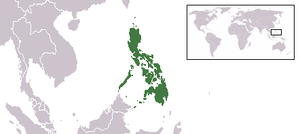Philippine Executive Commission
| Philippine Executive Commission | |
|---|---|
| Komisyong Tagapagpaganap ng Filipinas | |
 Location of the Philippines in Southeast Asia. | |
| Overview | |
| Established | January 1942 |
| Dissolved |
October 14, 1943 (succeeded by the Second Philippine Republic) |
| Country | Philippines (under occupation by the Empire of Japan) |
| Leader |
|
| Headquarters | Manila |
The Philippine Executive Commission (PEC; Tagalog: Komisyong Tagapagpaganap ng Filipinas)[1] was a provisional government set up to govern the Philippine archipelago during World War II. It was established with sanction from the occupying Imperial Japanese forces as an interim governing body prior to the establishment of the Japanese-sponsored and nominally independent, Second Philippine Republic.
History
Establishment
The Philippine Executive Commission (PEC) was established on January 1942 with Jorge B. Vargas as its first Chairman. It largely mirrored the Civilian Emergency Administration earlier appointed by President Manuel Quezon to administer the open city status of Manila and composed by the same officers that comprised the latter PEC. The PEC was created as the provisional caretaker government of the Greater Manila Area and eventually of the whole Philippines during the Japanese occupation of the country during World War II.
The PEC formally abolished all political parties on December 8, 1942, by virtue of Proclamation No. 109 creating the "Kapisanan sa Paglilingkod sa Bagong Pilipinas" (Association for Service to the New Philippines) or better known as the KALIBAPI.
The "KALIBAPI" was established to aim at the mental education, moral regeneration, physical invigoration, and economic rehabilitation of the Philippines under the guidance of the Japanese Military Administration. It was tasked to foster strong cooperation with the Japanese as part of the Order Great East Asia that promotes the lifting of the "great Oriental race." The "KALIBAPI" was appointed as a strong right arm of the Japanese occupational forces of the Philippines.
Towards a Japanese-sponsored Independence
Framing a Constitution

On May 6, 1943, Japanese Premier Hideki Tojo during a visit to the Philippines pledged to establish the Republic of the Philippines. This pledge of Tojo prompted the "KALIBAPI," to call for a convention on June 19, 1943, and twenty of its members were elected to form the Preparatory Commission for Independence. The commission tasked to draft a constitution for the Philippine Republic and elected head was José P. Laurel.
The Preparatory Commission presented its draft Constitution on September 4, 1943, and three days later, the "KALIBAPI" general assembly ratified the draft Constitution.
National legislature
By September 20, 1943, the "KALIBAPI's" representative groups in the country's provinces and cities elected from among themselves fifty four (54) members of the Philippine National Assembly, the legislature of the country, with fifty four (54) governors and city mayors as ex officio members.
Three days after establishing the National Assembly, its inaugural session was held at the pre-war Legislative Building and elected Benigno Aquino, Sr. as its first Speaker and José P. Laurel as President of the New Philippine Republic.
Declaration of the Second Philippine Republic
The Japanese-sponsored establishment of the Republic of the Philippines was proclaimed on October 14, 1943, with José P. Laurel being sworn-in as President.
On the same day, a "Pact of Alliance" was signed between the new Philippine Republic and the Japanese government that was ratified two days later by the National Assembly.
The Philippine Republic was immediately recognized by Japan, and in the succeeding days by Germany, Thailand, Manchukuo, Burma, Croatia and Italy while neutral Spain sent its "greetings."
The first act the National Assembly and the Laurel administration passed was the creation on December 3, 1943, the Food Administration Office that grouped together under its umbrella all existing food control agencies. The new administration that was crafted out of the establishment of a Japanese-sponsored Philippine Executive Commission was barely managing a food shortage that grappled the whole country, allocating basic food stuffs left available by the Japanese military who prioritized allocation in favor of sustaining their war efforts.
See also
References
- ↑ Añonuevo, Roberto. "Paglingon sa Ugat ng Komisyon sa Wikang Filipino" (in Filipino). Komisyon sa Wikang Filipino. Archived from the original on 12 March 2015. Retrieved 12 December 2017.
Gayunman, noong 1942 ay inihayag ng Komisyong Tagapagpaganap ng Filipinas [Philippine Executive Commission] ang...
Further reading
- "By Sword and Fire: The Destruction of Manila in World War II, 3 February-3 March 1945" by Alphonso J. Aluit (1994). Bookmark, Inc. 1994. ISBN 971-569-162-5